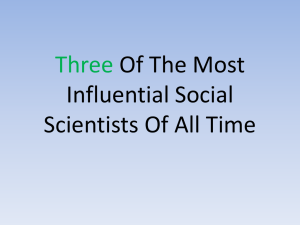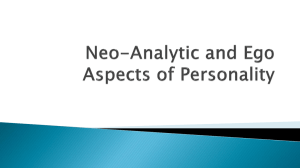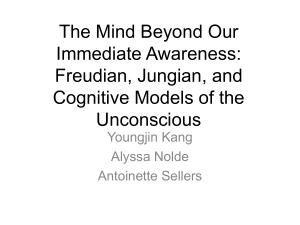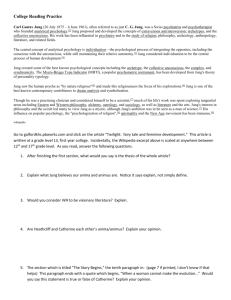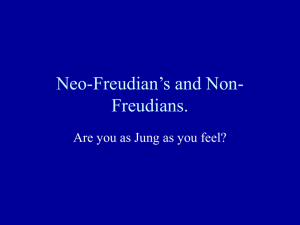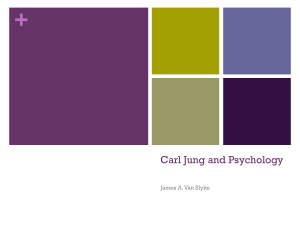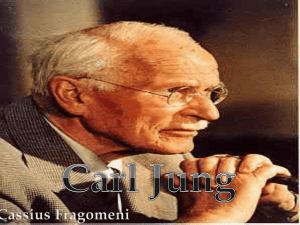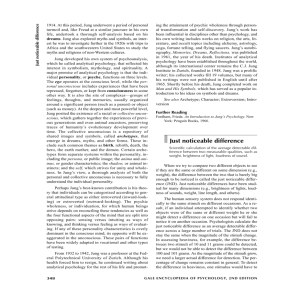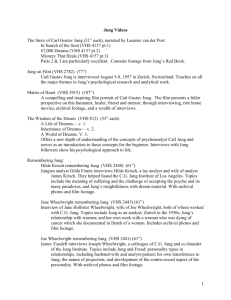The Second Half of Life - Beacon Unitarian Universalist Congregation
advertisement
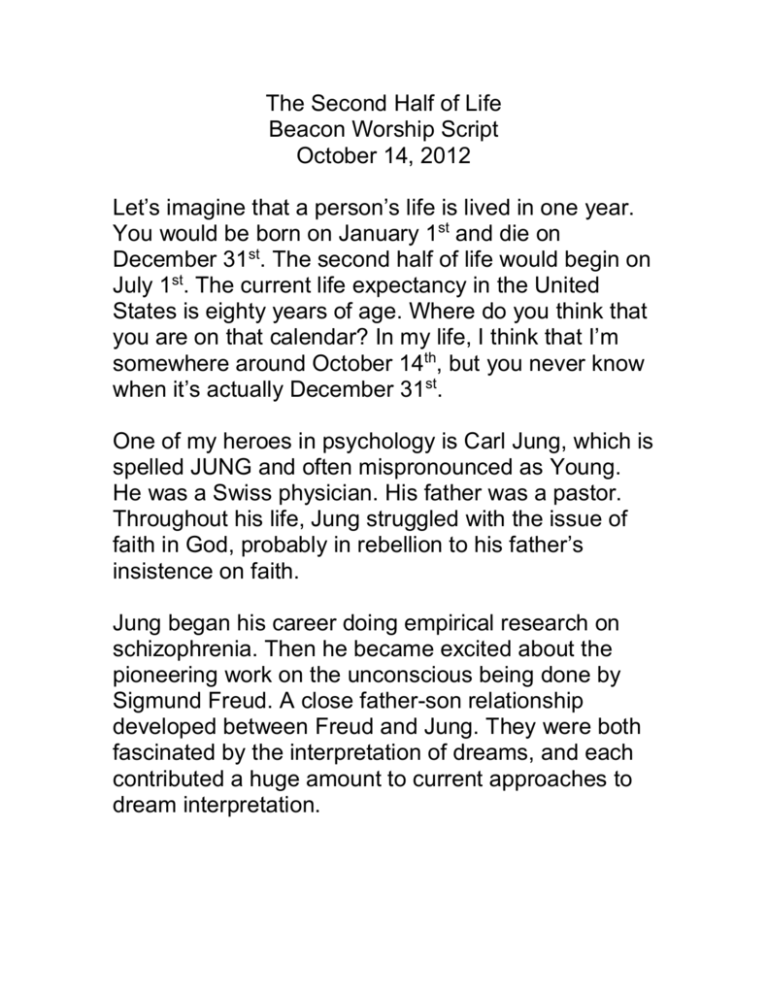
The Second Half of Life Beacon Worship Script October 14, 2012 Let’s imagine that a person’s life is lived in one year. You would be born on January 1st and die on December 31st. The second half of life would begin on July 1st. The current life expectancy in the United States is eighty years of age. Where do you think that you are on that calendar? In my life, I think that I’m somewhere around October 14th, but you never know when it’s actually December 31st. One of my heroes in psychology is Carl Jung, which is spelled JUNG and often mispronounced as Young. He was a Swiss physician. His father was a pastor. Throughout his life, Jung struggled with the issue of faith in God, probably in rebellion to his father’s insistence on faith. Jung began his career doing empirical research on schizophrenia. Then he became excited about the pioneering work on the unconscious being done by Sigmund Freud. A close father-son relationship developed between Freud and Jung. They were both fascinated by the interpretation of dreams, and each contributed a huge amount to current approaches to dream interpretation. At one point Jung was the heir apparent of the psychoanalytic movement. But just as Jung rebelled from his own father, he eventually rebelled from Freud’s insistence that sexuality and aggression were the primary unconscious motives behind most human behavior. Jung argued that people are motivated by many positive and negative unconscious forces. He created his theory of archetypes, which asserts that there are unconscious symbols, images, and themes that underlie all cultures. That evolved into his theory of the collective unconscious. His mistress, Toni Wolfe, got him interested in astrology, Tarot, and extrasensory perception. He did some interesting empirical research on the astrology of marital compatibility. Near the end of his life he developed the term synchronicity, which means things that move together in time but have no apparent physical causality. That was a catch-all concept that meant that events can be psychologically and spiritually significant but have no physical explanation. It bridged scientific psychology with mysticism. His mystical concepts got him marginalized by psychology in America, even though he was one of the pioneers of psychoanalysis and added ideas like introversion and extroversion to the language of psychology. Jung’s ideas of archetypes and the collective unconscious have had greater influence in religion and art. When George Lucas came up The Force for the Star Wars movies, it was based on Jung’s collective unconscious. With his interest in the convergence of science and mysticism, Carl Jung probably would have liked Unitarian-Universalism. Carl Jung agreed with Freud that the first half of life is about the development of the ego, which is the sense of self. During childhood, adolescence, and young adulthood, we individuate from our parents. Over time, we create our own independent relationships, and hopefully establish our own marriages and families. We develop are our own career paths. Eric Erickson reformulated Freud and Alfred Adler and began modern developmental psychology. For those of you who teach at NAU, student development theory is an offspring of the concepts of psychosocial development and individuation. But Jung was more interested in the second half of life than the first half of life. For Jung, psychological life starts to get really exciting after July 1st. Jung asserted that individuation never stops. If the first half of life is about acquiring an ego so that we fit into society, then he second half of life is about letting go of our egos. It is about letting go of our parental, social, and vocational identities. We become stripped bare of the social constraints that define us. The second half of life is the time of the soul. The original definition of psychology was not the study of behavior. Psyche-ology was the study of the soul. Jung believed that we all have an innate personality inside of us, which is consistent with his knowledge of astrology. There is an inner “Self” that is present at the moment of birth. Then we learn to adapt and mask that “Self” to fit into the social and economic realities of the world. During the second half of life, that sense of “Me” begins to express itself. For example, someone who is pressured into being extroverted to make friends in high school may become more introverted. Someone may discover suppressed artistic talents that they never thought that they had. We individuate from society just like we individuate from our parents. We stop caring so much about what other people think of us and let our true Selves come to the surface. One of the ways that the concept of the second half of life has meaning to us as Unitarian-Universalists is the expression of spirituality in the second half of life. During the first half of life, people naturally want to fit into a spiritual community. They want certainty and identity. For example, I was raised a Methodist but experimented with being a Lutheran because I had friends who were Lutherans. I went to an Episcopal church once because a girl that I had a crush on was an Episcopalian. Of course, I don’t think that she ever knew I had a crush on her because I was too nerdy to tell her. I probably abandoned religion when I went to college because it wasn’t cool and intellectual to believe in Jesus. I’m sure that I explored Eastern religions because that was cool in the 1960’s and 1970’s. I believed more in the Beatles than I did in God. I found my spiritual identity in mysticism rather than organized religion. That describes the spiritual path of many people of my generation. During the second half of my life, my inner “Self” has started to express itself. One part of that inner “Self” is being a spiritual person. As many of you know, I joined the Beacon Unitarian-Universalist Congregation because I had a dream that I was supposed to join a church. I trusted that my dream came from my connection to the collective unconscious, which is my understanding of this thing we call God. The inner “Self” in all of us is often expressed through dreams. My dream led me here. I think that I was ready to join a church because I didn’t really care if other people thought that I was cool or not. I knew that I was too nerdy to ever really be cool anyway. Instead I followed that quiet inner voice that gets louder in the second half of life. I soon learned that spiritual development occurs best in community. Carl Jung would have approved of a community that blends science, mysticism, and compassion. The second half of life is a time of psychological freedom. We are called to be our true Selves. I can’t imagine anything that is more spiritual than becoming our true Selves. That is the gift of the second half of life.

